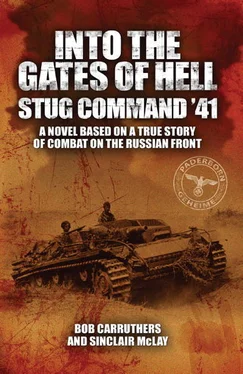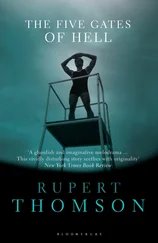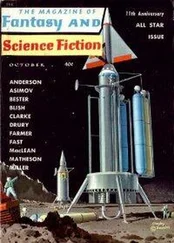“Traction is good, Herr Major,” replied the driver.
The submerged machines were relatively easy to steer as buoyancy lightened them, but the problem was to keep the momentum going forward on the soft floor of the river. Even with good traction, with no visual aids the short journey seemed to take an eternity. Major Jurgen Rondorf took comfort from the fact that the Tauchpanzer could operate in depths of up to fifteen metres and according to the best intelligence reports the river Bug was no deeper than five metres… But who knew for certain that there were no underwater trenches or potholes which could swallow up the tank? After what seemed like a lifetime, twenty-two tanks emerged from the river. A series of small explosions followed as the ignition wires blew off the covering sheets as soon as the tanks surfaced, leaving the vehicles ready for action.
“Now let’s see what the Reds are made of,” said Rondorf.
As the tanks forged ahead all along the frontier the German forces were experiencing success and beginning a war of movement. Pontoons, barges and emergency bridges joined the captured crossings and the river was almost immediately forded. Within minutes, armoured spearheads of Army Group Centre moved on in the direction of Minsk and Smolensk. South of Brest too, at Koden, following the successful assault on the bridge, the surprise attack of XXIV Panzer Corps, under General Freiherr Geyr von Schweppenburg, had gone according to schedule. The tanks crossed the bridge, which had been captured intact. The advanced units of Lieutenant-General Model’s 3rd Panzer Division crossed on rapidly built emergency bridges, the commanders standing in the turrets, scanning the landscape for the rearguards of the retreating Soviet frontier troops, overrunning the first anti-tank-gun positions, waving the first prisoners to the rear and moving nearer and nearer to their objective for the day◦— Kobrin, on the Mukhavets.
The pattern of events was far less dynamic for von Schroif and his command. As they crossed the rail bridge and approached the fortress the receding darkness of the night was now lit by hundreds of fires raging in buildings and shattered vehicles. The scattered bodies in grey uniforms which littered the cobbled street bore mute witness to the ferocity of the defence. Rifle fire was coming thick and fast from behind the steep walls of the fortress. Machine-gun fire began to rattle on the sides of the vehicles, causing the crews to close and lock their hatches.
The initial ferocity of the surprise attack by the Germans was debilitating and disorientating for the Russian defenders. As they groped towards some kind of cohesive response a group of German submachine-gunners led by Leutnant Weissheim picked their way through the chaos of explosions, flames and falling masonry. Initially, they encountered only a few dazed survivors, many of whom were not even fully dressed.
“Don’t stop for prisoners!” screamed the lieutenant again and again during their advance as time and again the hapless victims were cut down by a ruthless stream of submachine gun bullets which ripped their targets apart. In the initial confusion Weissheim and his command were able to penetrate the Terespol gate, leaving it to be secured by those coming behind them, and were able to use the ensuing chaos to stealthily make their way to the centre of the citadel. There, as ordered, the submachine-gunners occupied the regimental club building, which dominated the entire citadel. This building was situated on a piece of rising ground and stood above all the other buildings with a commanding all-round view of the environs of the fortress.
“Quickly!” Weissheim barked, “bring the transmitter over here and let’s get it operational now!”
Under Weissheim’s watchful eye the radio operators set up a radio transmitter inside the main room of the club. As soon as the device was in operation the artillery spotter from the 45th Infantry Division took control and without further ado began to guide the gunfire of the nearby German artillery units which soon became murderously accurate.
In the opening moments of Operation Barbarossa the defending units of the fortress of Brest-Litovsk suffered from the fact that they were not on a war footing and many didn’t even occupy the positions within the ambit of the fortress. Some of the units were assigned to defence construction works and others were in training. On the night of the attack there were between 7,000 and 8,000 men from various units, including personnel of the garrison hospital and medical unit. In addition, the families of many of the servicemen were inside the fortress.
From the very first minute of the war the fortress was bombed and shelled by every available calibre of German artillery. Severe close quarters fighting also erupted throughout the fortress. The 45th Division formed in Hitler’s Austrian homeland was chosen to deliver the full thrust of the attack. The division had been active in the occupation of Poland and France and served with distinction where it had suffered 462 casualties. Now it undertook the storming of the fortress, for which it was reinforced with five hundred guns, capable of firing four thousand shells per minute, all of which were trained on the fortress.
The barrage which broke upon the heads of the Russian defenders came with a force that no one had ever experienced before. This gigantic concentration of firepower literally shook the earth. Four thousand shells per minute were fired into the four-square-kilometre fortress. Who was in the fortress when this fearful blow was struck? In the months before the war began, the garrison in the fortress numbered about 14,000 officers and men. At the end of June, however, many units were engaged in defensive construction works or were in training camps.
On the night before the attack, there were 7,000 to 8,000 men from various units, including the personnel of the garrison hospital and medical unit. Thousands of wives and children of the servicemen were also inside the fortress.
Despite the chaos which immediately ensued, in the first few hours of the war, just before the fortress was encircled, approximately half of the garrison managed to slip out of the fortress and avoid the closing German pincers. This left a force amounting to around 3,500 officers and men to defend the fortress. They were to write their names in legend.
Five to ten minutes before the beginning of the artillery fire, German assault units captured the bridges across the Bug River, which units of the 12th Army Corps then crossed, heading for Brest. A massive column of enemy panzers moved northwards and southwards of Brest, bypassing the city as they headed eastwards.
During the opening barrage the Germans had aimed their artillery fire at the entrance gates, bridgehead fortifications, bridges, artillery and auto-parks, warehouses and the ammunition stores. The curtain of fire was moved 10 metres deeper every 4 minutes. It was followed by the assault groups of the 45th Infantry Division. The majority of the warehouses were ruined and destroyed. Within minutes the water supply was disrupted and there was no possibility of a connection with headquarters. The majority of the soldiers and officers were killed or wounded and the defence was fragmented into islands of resistance.
An already bleak situation began to look even more dangerous for the defenders as further groups of German submachine-gunners began to move towards the Cholm gates on the south island and the Brest gates on the northern Kobrin island. It was clear that these units would soon link up, with the aim of fully taking over the centre of the fortress.
Decisive measures were desperately needed, and the man for the hour arrived in the shape of the commissar of the 84th Rifle Regiment, Senior Political Instructor Yefim Fomin.
Читать дальше












